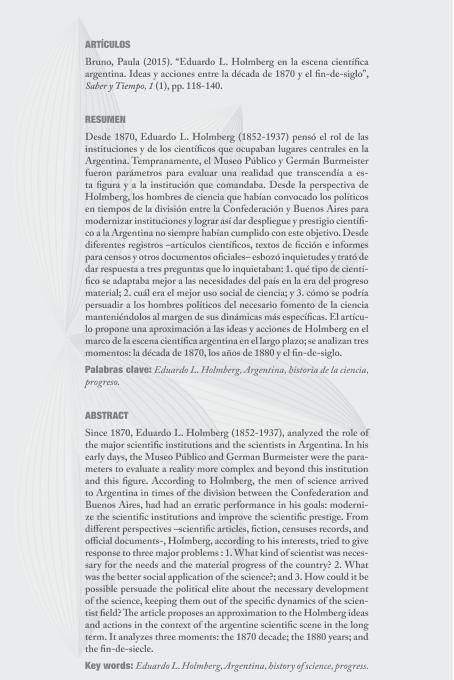Artículo
Desde 1870, Eduardo L. Holmberg (1852-1937) pensó el rol de las instituciones y de los científicos que ocupaban lugares centrales en la Argentina. Tempranamente, el Museo Público y Germán Burmeister fueron parámetros para evaluar una realidad que transcendía a esta figura y a la institución que comandaba. Desde la perspectiva de Holmberg, los hombres de ciencia que habían convocado los políticos en tiempos de la división entre la Confederación y Buenos Aires para modernizar instituciones y lograr así dar despliegue y prestigio científico a la Argentina no siempre habían cumplido con este objetivo. Desde diferentes registros - artículos científicos, textos de ficción e informes para censos y otros documentos oficiales-, esbozó inquietudes y trató de dar respuesta a tres preguntas que lo inquietaban: 1. qué tipo de científico se adaptaba mejor a las necesidades del país en la era del progreso material; 2. cuál era el mejor uso social de ciencia; y 3. cómo se podría persuadir a los hombres políticos del necesario fomento de la ciencia manteniéndolos al margen de sus dinámicas más específicas. El artículo propone una aproximación a las ideas y acciones de Holmberg en el marco de la escena científica argentina en el largo plazo; se analizan tres momentos: la década de 1870, los años de 1880 y el fin-de-siglo. Since 1870, Eduardo L. Holmberg (1852-1937), analyzed the role of the major scientific institutions and the scientists in Argentina. In his early days, the Museo Público and German Burmeister were the parameters to evaluate a reality more complex and beyond this institution and this figure. According to Holmberg, the men of science arrived to Argentina in times of the division between the Confederation and Buenos Aires, had had an erratic performance in his goals: modernize the scientific institutions and improve the scientific prestige. From different perspectives –scientific articles, fiction, censuses records, and official documents-, Holmberg, according to his interests, tried to give response to three major problems : 1. What kind of scientist was necessary for the needs and the material progress of the country? 2. What was the better social application of the science?; and 3. How could it be possible persuade the political elite about the necessary development of the science, keeping them out of the specific dynamics of the scientist field? The article proposes an approximation to the Holmberg ideas and actions in the context of the argentine scientific scene in the long term. It analyzes three moments: the 1870 decade; the 1880 years; and the fin-de-siecle.
Eduardo L. Holmberg en la escena científica argentina: Ideas y acciones entre la década de 1870 y el fin-de-siglo
Fecha de publicación:
09/2015
Editorial:
Universidad de San Martín
Revista:
Saber y Tiempo
ISSN:
2451-7658
Idioma:
Español
Tipo de recurso:
Artículo publicado
Clasificación temática:
Resumen
Archivos asociados
Licencia
Identificadores
Colecciones
Articulos(INSTITUTO "DR. E.RAVIGNANI")
Articulos de INST. DE HISTORIA ARGENTINA Y AMERICANA "DR. EMILIO RAVIGNANI"
Articulos de INST. DE HISTORIA ARGENTINA Y AMERICANA "DR. EMILIO RAVIGNANI"
Citación
Bruno, Paula Graciela; Eduardo L. Holmberg en la escena científica argentina: Ideas y acciones entre la década de 1870 y el fin-de-siglo; Universidad de San Martín; Saber y Tiempo; 1; 1; 9-2015; 118-140
Compartir




